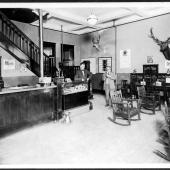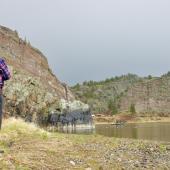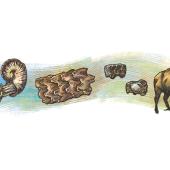Ghost Towns of Northwest Montana
As sunlight shines through the cracks of a dark log cabin’s ceiling, a spider crawls over the rusted remains of an oil lantern. The width of a jail cell and the height of its occupant, the cabin served as sleeping quarters for a lonely miner whose most common company might have been the cold winds seeping through the cracks of its now grayed walls.
Whether gold, silver or shimmering gems, news of buried treasure sent settlers to the mountains of Montana throughout the last half of the 1800s. Thousands loaded packs, carrying little more than picks, pans and the clothes on their back.

Businessmen and their families followed suit. Horses and wooden wagons blazed trails over torrential peaks to the mining camps. Sprawling cities were formed along dirt avenues. Within months, homes, stores and hotels began springing up to serve those that hoped to strike it rich. Churches and saloons battled for crowds.
But as successful as they were, the back-wood mining towns disappeared.
Each relied upon the mines to bring money. When they dried u or the markets no longer sought the precious metals deep in the ground, mills ceased working. Entire towns moved, and the buildings were left to their foundations to support them. Most of those couldn’t stand up to the forces of time and nature.
Marysville
Born and raised in Marysville, Debbie Peterson remembers hearing the story of Thomas Cruse, who established the town of Marysville in 1876. Peterson’s great-grandfather was one of the first to follow Cruse to the valley. Her family has shared the town’s history ever since.
“Everybody called him ‘Crazy Tom’ when he was panning for silver,” she said. Banks wouldn’t front him any money and his future seemed bleak. But the man who obsessed over the hills near the town struck gold. “Then they called him ‘Mr. Cruse.’ By the time he died, they called him ‘Colonel Cruse,” she said.
Cruse named the mine Drumlummon after his native home in Ireland, and the town of Marysville after one of its first female citizens, Mary Ralston. After selling the rights to the mine he built banks in Marysville and Helena and funded the St. Helena Cathedral. But the prosperous times for the Drumlummon mine didn’t last forever.
“(Marysville) has kind of grown and crashed a couple times,” Peterson said.
Today about 80 residents inhabit the new homes that surround town’s history. Hidden between the steel garages and colorful houses are the dilapidated remains that Marysville residents call their ghost town. A few older homes that rest along the town’s western hill have been left to decay. Meanwhile, some buildings have been preserved and repaired, such as the Methodist Episcopal Church, built in 1886; it is listed in the National Register of Historic Places and now under private ownership. With the exception of the ancient wooden boards that cover the windows, the building appears brand new.
“Everybody in town has one thing in common,” she said. “We want to save the integrity of the town.”
Almost everyone in Marysville is a member of the Pioneer Club, which works to save and restore the aging buildings. Every second Saturday in July, members organize the annual Marysville Picnic, a spectacle that is gaining attention across the state. This year, more than 300 people registered at the 37th picnic, bringing in nearly $5,800.
Located about 30 minutes from Helena, Marysville is accessible only by dirt road. The town is inhabited by an eclectic group of people who tend to drive trucks and SUVs and meet at the Marysville House, a rustic bar and grill that, some say, serves the best steaks in the state.
On every street corner is a wooden sign naming the intersecting dirt roads, and resting on top are metal figurines. The two-dimensional carvings, such as the Grand and 3rd Street’s scene with two horses pulling a man on a sleigh, represent the old days of the town. The signs were donated by Harry McGee, who first visited Marysville on a winter’s day 11 years ago and immediately bought a house. He said he preferred looking out his front door and seeing the mountains, not city.
“The hustle and bustle is gone,” he said. “No sirens, no fires, no cops.”
Garnet
Resting in a glass case in Garnet’s Visitor’s Center is a mangled prosthetic arm pieced together with steel and leather and topped off with a rusty hook. It is the last remains of a miner known simply as “Shorty.”
After a night of drinking, Shorty lost a few more inches when he fell into a fire and badly burned his right arm. According to www.garnetghosttown.org, a Web site designed by the Garnet Preservation Association, Dr. Armistead Mitchell was called on to help the injured miner. Mitchell often rode his horse into the Beartown mining camp, a settlement in the Garnet Mountain Range beginning in the 1860s, from his Deer Lodge home.
On that day, Mitchell sawed off the scorched remains of Shorty’s arm. Anesthetized by whiskey, Shorty invited the doctor to an all-night poker party in which both participants became inebriated. The next morning, Mitchell rode off with Shorty’s burnt arm, intending to save it for dissection. But, in his intoxicated state, Mitchell lost the appendage somewhere along the trail.
Like the hard-drinking story of Shorty and Dr. Mitchell, much of Garnet ghost town’s history has been preserved. It is the most intact ghost town in the state, and the Garnet Preservation Association along with the Bureau of Land Management have worked together to keep its history alive.
More than 20 structures still exist on the land designated for Garnet, some under private ownership. Still standing are buildings like Frank A. Davey’s store, among the first structures built in Garnet around 1898, and the J.K. Wells Hotel, often visitors’ favorite destination.
“(The J.K. Wells Hotel) has really interesting artifacts and the structure itself is beautiful,” said Laurie Johnson, who works in the Visitor’s Center, formerly the Dahl’s Saloon. “You can go all the way to the third floor and it was one of the fanciest hotels in the state.”
Erected in the winter of 1897, the hotel was the most impressive building in Garnet. Its entryway contained double doors with stained glass windows. With its elaborate woodwork, it was often compared to the luxurious buildings in Helena.
Its first floor provided for lounging and dining with a small, furnished ladies’ parlor and a grand dining room where events like the Grande Masquerade, the Hard Times Ball and the St. Patrick’s Day Calico Ball were held. Old-fashioned tables and unsteady chairs still remain in the dining hall, and organizers have set up a number of artifacts for visitors to ponder. The second floor contains a number of rooms where guests rested on tidy beds, but the third floor shows the kindness of the hotel’s owners. Long one x two sticks are still nailed into the floor, designating where the poorest of miners could lay down their bedrolls and sleep. In the ceiling were skylights so that the miners who spent much of their days hidden underground could sleep underneath the stars.
Those willing to visit Garnet, just east of Missoula off Highway 200, can walk through most of the buildings still erect. They can see the saloons and speakeasy where miners spent their leisure hours, or the homes of prominent families like the Adams’ house. After all, Garnet was a family-oriented place. Its school held 41 students in 1898 and entrepreneurs, such as Frank Davey, encouraged families to move to the town with his “Honeymoon cabin.” Built by a miner, the cabin was acquired by Davey after the miner left. In 1917, he let newlyweds live in it rent free until they found their own place or another couple got married.
Like many ghost towns in Montana, Garnet had a series of booms and busts. After 1900, gold became scarcer and harder to mine. Its population dropped until President Franklin Roosevelt raised the price of gold from $16 to $35 an ounce. Garnet revived, but World War II drew the population away until only a few residents remained.
Visitors today can vacation in the town. Existing cabins, such as the home of Ole and Marion Dahl, the last permanent residents of the town, can be rented throughout the winter – a perfect spot for snowmobilers.
For more information write or call: Cabin Rental Program, 3255 Fort Missoula Road, Missoula, Montana 59804, Phone: (406) 329-3914
Granite
The Miner’s Union Hall in Granite stands hollowed out. Its metal pillars and brick archways raise only a few layers of stone. They are the last remnants of a building that used to stretch three stories high. Lit by giant oil lamps (one as heavy as 400 pounds) the Hall used to house the local offices for the miners’ union, clubs and secret orders and, on its second floor, a “spring floor” for large dances. It was the center of the richest silver mining town in the state. A town nicknamed “Montana’s Silver Queen.”
According to www.philipsburgmt.com, Eli Holland is said to have found a piece of high-grade ruby silver while following a wounded game animal in 1872. After Charles McLure found a piece of silver ore nearly five years later, he traveled east to St. Louis to obtain capital for exploration and development.
After months of failed attempts, backers sent word to end the mining. According to the Montana Department of Fish Wildlife and Parks Web site, the telegraph to close the mine was delayed and within hours of nearly being closed down, the last blast on the last day uncovered a bonanza. The site opened $40,000,000 worth of silver.
Quickly, the peaks six miles uphill from the small town of Philipsburg were filled with homes, businesses and schools.
Granite offered 18 saloons, a thriving red light district, a baseball park and hospitals. Its 3,000 inhabitants enjoyed amenities like a water system, named streets and a bank. It boasted as many stores and commercial establishments as major Montana cities at that time. But unlike the other cities in Montana, Granite’s boom came to a screeching halt.
On July 31, 1893, the U.S. Congress repealed the Sherman Act resulting in lower silver prices. Within 24 hours almost all of the town’s inhabitants had left, grabbing what they could and leaving their homes and possessions behind. One year later, only 140 people remained.
Today, all that remains are ruins – evidence of a once great city whose entire purpose surrounded the giant mines. Since its abandonment, the town has been riddled by the devastating effects of the environment. Fire consumed most of the buildings while others have slowly decayed. Trees and plants have broken through the center of the establishments, and signs mark small footpaths through forests signifying where a large avenue once ran.
However, the Granite Mountain Mining Company’s two giant mills with their wooden beams and stone archways still stare over the valley below. But without a purpose they, too will fall.
~ Jeff Windmueller, a graduate of UM’s School of Journalism, is a former news editor with the Montana Kamin; he won the Montana Newspaper Association’s Dean Stone Award in 2004.












Leave a Comment Here